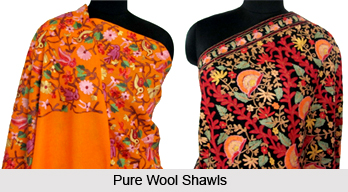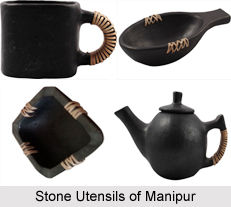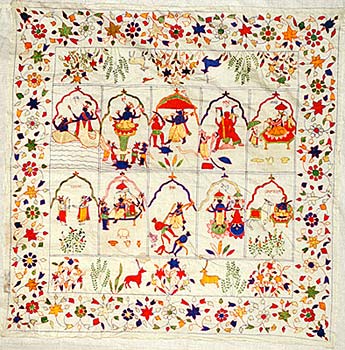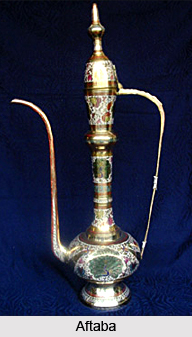 Situated in the northeastern part of the country, Nagaland is an important part of the colourful culture of India. A Naga shawl is the most important part of the dress and is woven with cotton and staple fibre, though some wool is used. Shawls vary from simple white ones to elaborately designed ones with symbols and colours. The tsung kotepsu has a white woven band stitched along the centre of the shawl and is woven over with figures of elephants, tigers, mithuns, cocks, and circles, representing human heads. It has horizontal black, red, or white stripes. A rich and brave man`s acquisitions and achievements are picturised on it. The lotha naga shawl is woven in nine parts and stitched together. Many traditions and beliefs are associated with the weaving and wearing of the traditional dress. When a Konyak woman gets married she wears a shatni shawl which is preserved and used only to wrap her dead body. Convention demands that a rongtu shawl be worn only if the mithun sacrifice has been conducted over three generations.
Situated in the northeastern part of the country, Nagaland is an important part of the colourful culture of India. A Naga shawl is the most important part of the dress and is woven with cotton and staple fibre, though some wool is used. Shawls vary from simple white ones to elaborately designed ones with symbols and colours. The tsung kotepsu has a white woven band stitched along the centre of the shawl and is woven over with figures of elephants, tigers, mithuns, cocks, and circles, representing human heads. It has horizontal black, red, or white stripes. A rich and brave man`s acquisitions and achievements are picturised on it. The lotha naga shawl is woven in nine parts and stitched together. Many traditions and beliefs are associated with the weaving and wearing of the traditional dress. When a Konyak woman gets married she wears a shatni shawl which is preserved and used only to wrap her dead body. Convention demands that a rongtu shawl be worn only if the mithun sacrifice has been conducted over three generations.
Naga Shawl
The Naga shawl is the most important part of their dress. Each tribe has its own patterns with simple clean lines, stripes, squares and bands being the most traditional design motifs. Naga fabrics retain their original attractive patterns, yet external influences on colour and design are also evident.
 Procedure of making Naga Shawl
Procedure of making Naga Shawl
The looms used are mostly narrow loin looms. Technically, Naga loom consists of a simple back-strap with a continuous horizontal warp consisting of six sticks serving as the warp beam, lease rod, heald stick, beating sword and extra warp beam. Loin loom products mainly shawls are woven with a rayon weft. The Naga shawl weaving is done mostly with cotton , the staple fibre though some wool is used. The centre of the shawl is woven over with figures of elephants, tigers, mithun, cocks and circles, representing human heads. The fabrics are dyed in indigenous colours.
Pure-wool Shawls Blanket
Weaving without ornamentation is an age-old tradition in U.P. hills.The pure-wool shawls blanket from hilly areas of Uttar Pradesh specially Almora and Nainital are reputed for their warmth, softness and subtle beauty.
Fine Art of Shawl
Sheep with thick fleece are raised in the higher mountains of Uttar Pradesh. The wool is spun by men and women in long winter seasons.This provides both warmth and softness. Panki is used as a wrap around with fur touching the body.The pashmina weaving is not as fine as in Kashmir but has it own softness, warmth and grace. Panki is heavy shawl with hair on one side. Thulma has hair on left sides.
Procedure of Shawl making
Twill weave and plain weave techniques are used for weaving. Traditionally, soothing natural vegetable colours were used in shades of yellow, orange, brown and grey. Currently, synthetic colours are also used. They are woven using 2 to 4 ply hand spun yarns in 10 sq. /13 sq. count with plain, twill or diamond weaves and simple geometrical designs. The softness of the end product is achieved through the hand-finishing processes without use of any mechanised equipment.

Many speculations have been made by historians about the origin of Kashmir shawls. The local tradition held so far is that the founder of the shawl industry was Zain-ul-Abidin (1421-72). He is said to have introduced the twill tapestry technique with the help of Turkistan weavers. It is also said that Mirza Haidar Tughlat was the originator of Kashmiri shawls. Mughal emperors also encouraged the shawl industry.
Fine Art of Shawl
Woollen shawls are popular because of the embroidery worked on them which is special to Kashmir. Wool woven in Kashmir is known as raffel and is always 100 per cent pure. Many kinds of embroidery are worked on shawls. Sozni or needle work is generally done in a panel along the sides of the shawls. Motifs, usually abstract designs or stylized paisleys and flowers are worked in one or two, occasionally three colour, all subdued. The fineness of the workmanship and the amount of embroidery determines the value of the shawl. Sozni is often done so skillfully that the motif appears on both sides of theshawl each side having a different colour. Another type of needle embroidery is popularly known as Ari work because of the design and the style in which it is executed. This is done either in broad panels on either side of the breadth of a shawl, or covering the entire surface of a stole. Flowers and leaves are worked in stem stitch in bright colours. A third type of embroidery is hook embroidery motifs better known as flower design finely worked in concentric rings of chain stitch. It is on pashmina shawls that Kashmir most exquisite embroidery is worked, sometimes covering the entire surface, earning it the name of Jamavar. A Jamavar shawl can, by virtue of the embroidery, increase the value of a shawls three - fold. Shahtoosh, the legendary rung shawl is incredible for its tightness, softness and warmth.
 Procedure of Shawl Making
Procedure of Shawl Making
Pattern drawing is the most important job, which is transferred to a graph by a highly skilled craftsman. The colouring is however, done by the colour caller with a black and white drawing before him, beginning at the bottom and working upwards calling out each colour, and the number of warps along which it is required to extend until the pattern is covered. All these designs are then transcribed into a coded pattern that the weavers can decipher and guide other by calling out aloud the number of warp ends to be covered in a particular coloured weft. A second weaver sits on the loom to accelerate the process and the chief weaver recites the weft repeatedly for him to follow. In some shawls there are two sided weaves, usually of the same design but sometimes in different colour schemes known as do-rookha.
Shawl Artifacts
Pashmina shawls, ring shawls, shahtosh shawl, kani shawls, jamavar shawls, amli shawls.



















